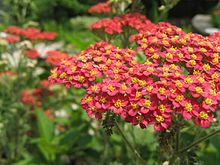Achillea millefolium has seen historical use as in traditional medicine, often because of its astringent effects. The herb is purported to be a diaphoretic, astringent, tonic, stimulant and mild aromatic. It contains isovaleric acid, salicylic acid, asparagin, sterols, flavonoids, bitters, tannins, and coumarins. It has been used as an anti-inflammatory or in chest rubs for colds and influenza. The leaves encourage clotting, so it can be used fresh for nosebleeds. The aerial parts of the plant are used for phlegm conditions, as a bitter digestive tonic to encourage bile flow, and as a diuretic. The aerial parts act as a tonic for the blood, stimulate the circulation, and can be used for high blood pressure; it is also useful in menstrual disorders, and as an effective sweating remedy to bring down fevers.
It is reported to be associated with the treatment of the following ailments:Pain, antiphlogistic, bleeding, gastrointestinal disorders, choleretic inflammation, emmenagogue, stomachache.
| Catalog | Product Name | CAS Number | Manual |
|---|---|---|---|
| CFN98731 | Artemetin | 479-90-3 | |
| CFN97530 | Artemetin acetate | 95135-98-1 | n/a |
A unique collection of 21 natural compounds from Humulus lupulus
A unique collection of 22 natural compounds from Phellodendron Chinense Schneid.
A unique collection of 21 natural compounds from Angelica dahurica(Fisch.et Hoffm.)Benth.et Hook.f.ex Franch.et Sav.cv.Hangbaizhi Hort.





